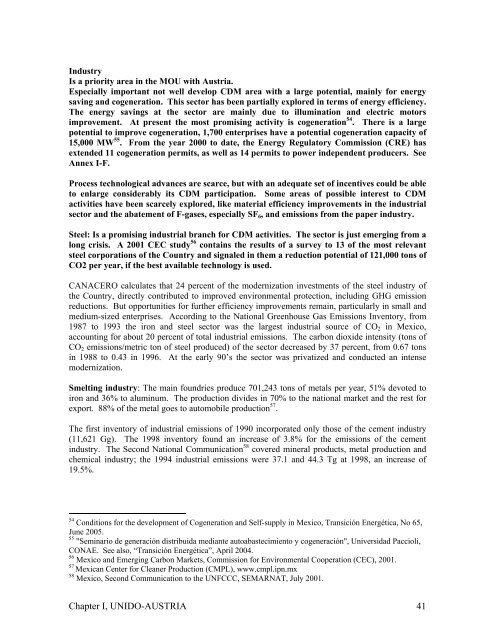mexico, support for the development and uptake of - Unido
mexico, support for the development and uptake of - Unido
mexico, support for the development and uptake of - Unido
Create successful ePaper yourself
Turn your PDF publications into a flip-book with our unique Google optimized e-Paper software.
Industry<br />
Is a priority area in <strong>the</strong> MOU with Austria.<br />
Especially important not well develop CDM area with a large potential, mainly <strong>for</strong> energy<br />
saving <strong>and</strong> cogeneration. This sector has been partially explored in terms <strong>of</strong> energy efficiency.<br />
The energy savings at <strong>the</strong> sector are mainly due to illumination <strong>and</strong> electric motors<br />
improvement. At present <strong>the</strong> most promising activity is cogeneration 54 . There is a large<br />
potential to improve cogeneration, 1,700 enterprises have a potential cogeneration capacity <strong>of</strong><br />
15,000 MW 55 . From <strong>the</strong> year 2000 to date, <strong>the</strong> Energy Regulatory Commission (CRE) has<br />
extended 11 cogeneration permits, as well as 14 permits to power independent producers. See<br />
Annex I-F.<br />
Process technological advances are scarce, but with an adequate set <strong>of</strong> incentives could be able<br />
to enlarge considerably its CDM participation. Some areas <strong>of</strong> possible interest to CDM<br />
activities have been scarcely explored, like material efficiency improvements in <strong>the</strong> industrial<br />
sector <strong>and</strong> <strong>the</strong> abatement <strong>of</strong> F-gases, especially SF 6 , <strong>and</strong> emissions from <strong>the</strong> paper industry.<br />
Steel: Is a promising industrial branch <strong>for</strong> CDM activities. The sector is just emerging from a<br />
long crisis. A 2001 CEC study 56 contains <strong>the</strong> results <strong>of</strong> a survey to 13 <strong>of</strong> <strong>the</strong> most relevant<br />
steel corporations <strong>of</strong> <strong>the</strong> Country <strong>and</strong> signaled in <strong>the</strong>m a reduction potential <strong>of</strong> 121,000 tons <strong>of</strong><br />
CO2 per year, if <strong>the</strong> best available technology is used.<br />
CANACERO calculates that 24 percent <strong>of</strong> <strong>the</strong> modernization investments <strong>of</strong> <strong>the</strong> steel industry <strong>of</strong><br />
<strong>the</strong> Country, directly contributed to improved environmental protection, including GHG emission<br />
reductions. But opportunities <strong>for</strong> fur<strong>the</strong>r efficiency improvements remain, particularly in small <strong>and</strong><br />
medium-sized enterprises. According to <strong>the</strong> National Greenhouse Gas Emissions Inventory, from<br />
1987 to 1993 <strong>the</strong> iron <strong>and</strong> steel sector was <strong>the</strong> largest industrial source <strong>of</strong> CO 2 in Mexico,<br />
accounting <strong>for</strong> about 20 percent <strong>of</strong> total industrial emissions. The carbon dioxide intensity (tons <strong>of</strong><br />
CO 2 emissions/metric ton <strong>of</strong> steel produced) <strong>of</strong> <strong>the</strong> sector decreased by 37 percent, from 0.67 tons<br />
in 1988 to 0.43 in 1996. At <strong>the</strong> early 90’s <strong>the</strong> sector was privatized <strong>and</strong> conducted an intense<br />
modernization.<br />
Smelting industry: The main foundries produce 701,243 tons <strong>of</strong> metals per year, 51% devoted to<br />
iron <strong>and</strong> 36% to aluminum. The production divides in 70% to <strong>the</strong> national market <strong>and</strong> <strong>the</strong> rest <strong>for</strong><br />
export. 88% <strong>of</strong> <strong>the</strong> metal goes to automobile production 57 .<br />
The first inventory <strong>of</strong> industrial emissions <strong>of</strong> 1990 incorporated only those <strong>of</strong> <strong>the</strong> cement industry<br />
(11,621 Gg). The 1998 inventory found an increase <strong>of</strong> 3.8% <strong>for</strong> <strong>the</strong> emissions <strong>of</strong> <strong>the</strong> cement<br />
industry. The Second National Communication 58 covered mineral products, metal production <strong>and</strong><br />
chemical industry; <strong>the</strong> 1994 industrial emissions were 37.1 <strong>and</strong> 44.3 Tg at 1998, an increase <strong>of</strong><br />
19.5%.<br />
54 Conditions <strong>for</strong> <strong>the</strong> <strong>development</strong> <strong>of</strong> Cogeneration <strong>and</strong> Self-supply in Mexico, Transición Energética, No 65,<br />
June 2005.<br />
55 "Seminario de generación distribuida mediante autoabastecimiento y cogeneración", Universidad Paccioli,<br />
CONAE. See also, “Transición Energética”, April 2004.<br />
56 Mexico <strong>and</strong> Emerging Carbon Markets, Commission <strong>for</strong> Environmental Cooperation (CEC), 2001.<br />
57<br />
Mexican Center <strong>for</strong> Cleaner Production (CMPL), www.cmpl.ipn.mx<br />
58 Mexico, Second Communication to <strong>the</strong> UNFCCC, SEMARNAT, July 2001.<br />
Chapter I, UNIDO-AUSTRIA 41
















